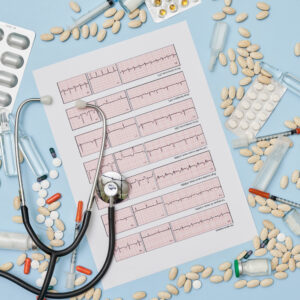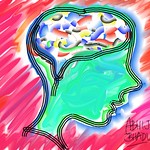AI development leads to lots of new possibilities of its applications in the modern world, including within healthcare.

June 23, 2023
7 ways AI could benefit healthcare
1) Clerical work
AI has the ability to optimise staffing, scheduling and resource planning within healthcare. It can be used to analyse data such as emergency room demand and admission rates in order to predict the necessary personnel and equipment.
It can also increase efficiency through the use of AI-powered speech recognition technology. This allows for the transcription of conversations with patients and analyses them for further information that may have been overlooked or misinterpreted by the doctor. AI can also improve efficiency with applications such as voice-to-text transcriptions which can write up a patient’s chart notes, fill prescriptions, and order tests.
The involvement of AI in healthcare is already ongoing as Microsoft and Epic Systems, a healthcare software company, announced their partnership on April 17, 2023.
Their goal is to apply AI technology to Epic’s records to improve productivity. The first application of this technology was to Epic’s MyChart software which is a way to access their health information and care team which is used by over 160 million people. This automatically generates draft responses to messages received by physicians from patients which they can choose to edit or send.
AI also provides a financial benefit as its cost-cutting role in administrative workflow has the potential of saving $18 billion by 2026.
2) Diagnosis and Avoiding Medical Errors
AI can play a role in diagnosis as it has the ability to access data simultaneously from billions of patients. Using this data with predictive analytics AI can help identify patients at higher risk of developing certain diseases. This means that doctors are able to intervene earlier to stop the development of a predicted disease. AI is also capable of carrying out the triaging of patients before they meet with a doctor allowing them to attend to those in need of urgent care faster.
Its role in medical imaging removes human error which can identify issues faster and lead to fewer misdiagnoses. The peer review process is the standard technique to confirm imaging results and ensure accurate diagnoses. However, only 3-5% of all the diagnostic images receive a second read through this process. AI however is able to review these images without taking away working hours from other healthcare professionals.
3) Improvement of Biopsy Procedures
AI can be applied to biopsies to improve accuracy. AI is being used by healthcare companies to build models able to analyse tumour biopsy images to identify mutations. This is cheaper and easier than full DNA sequencing and allows doctors to create more effective treatments.
Learn more:
This can be utilised in the diagnosis of breast cancer. Recent research in which AI-based tools were used as quality control for breast cancer review showed very high accuracy.
For example, the detection of invasive and ductal carcinoma (a type of breast cancer) was found to have a specificity of 93.51% and a sensitivity of 95.51%. This allows abnormalities to be identified which could easily be overlooked.
4) Monitoring and Analysing Vital Signs
The possibilities of AI also extend to the monitoring of patients. This would involve the constant analysis of vital signs, such as breathing rate, allowing AI to predict a crisis based on irregularities and alert the nurses. This would provide for less regular monitoring by nurses, therefore allowing them to focus their care where necessary.
These observations enable the use of personalised medicine as it can monitor the patient’s progress and any adverse reactions to treatment. This, paired with its wide range of data from other patients, enables the diagnosis of effective personalised treatment.
AI-powered tools also allow for the analysis of unstructured medical data. Medical images such as X-rays and MRIs can use AI to identify indications of disease and abnormalities more efficiently than human experts which would result in faster treatment.
5) Medical Robots
AI-driven medical robots are being used by hospitals to assist with surgical operations. This includes closing wounds and using medical data to provide insights into surgical procedures.
A study of 379 orthopaedic patients across 9 surgical sites found that the guidance of an AI-driven robot, created by an Israeli robotics company called Mazor Robotics, caused a five-fold reduction in surgical complications than surgeons operating on their own.
6) More Empathy Towards Patients
AI has the potential to provide improved care to patients by providing more compassionate responses than doctors.
A study by JAMA Internal Medicine in April 2023 showed the capabilities of AI to assist doctors when responding to patients. This involved both physicians and chatbots responding to 195 random questions from patients on a social media forum. A team of licensed healthcare professionals preferred the response of the AI 78.6% of the time across 585 evaluations. The professionals rated it as providing significantly higher quality and empathy demonstrating the possibilities of AI being used to assist in drafting responses to patients.
7) Reading Minds
A newly emerging application of AI is the possibility of decoding thoughts. This new system does not require surgery and produces a continuous stream of words.

Research has been conducted by the University of Texas using MRI scans to match certain words and ideas to patterns of brain activity. It currently has a 92-94% word-for-word error however it manages to grasp the ideas behind the thoughts.
The use of this technology however is limited in application to the person whose data was used to code it and will only work if the person is cooperating.
Challenges
The use of generative AI in responding to patients may cause issues as the technology could struggle to keep up with all the relevant data and therefore provide inaccurate responses. This means that the professional must determine the reliability of the advice themselves as acting on inaccurate information could further harm a patient’s health.
Generative AI is at risk of bias due to the data it is trained using, especially if that data does not represent the entire population it is meant to assist. This could create unsuitable treatment plans or diagnoses for patients.
There is also the additional risk of healthcare professionals relying too heavily on the assistance of AI tools meaning they are unable to make or trust judgements on their own.


